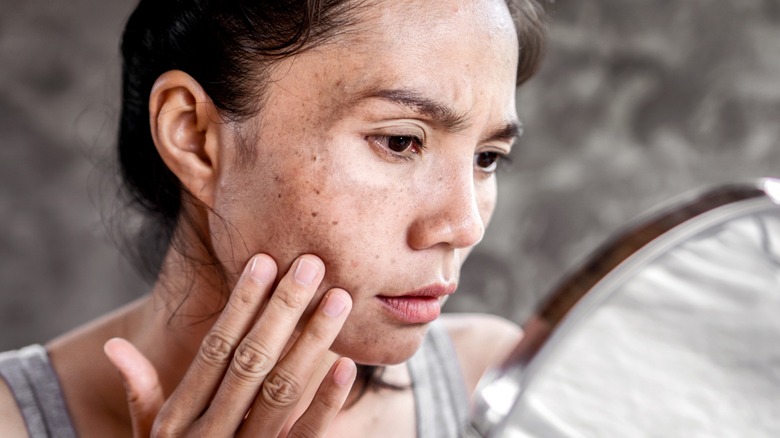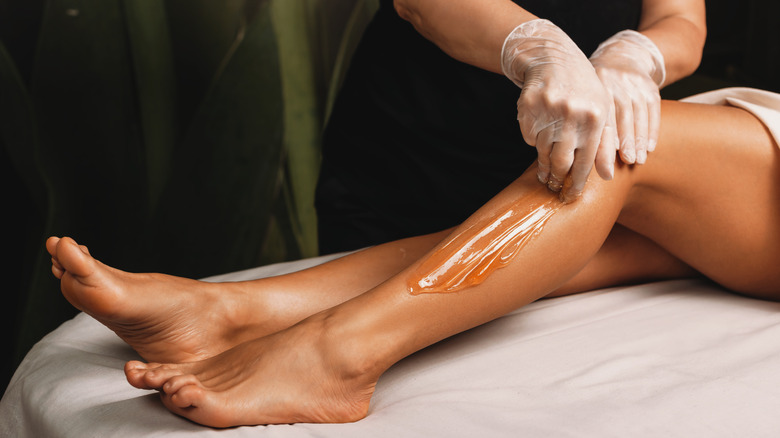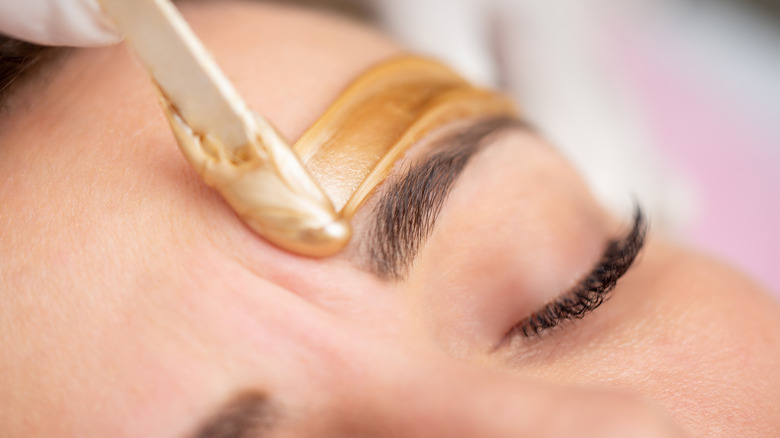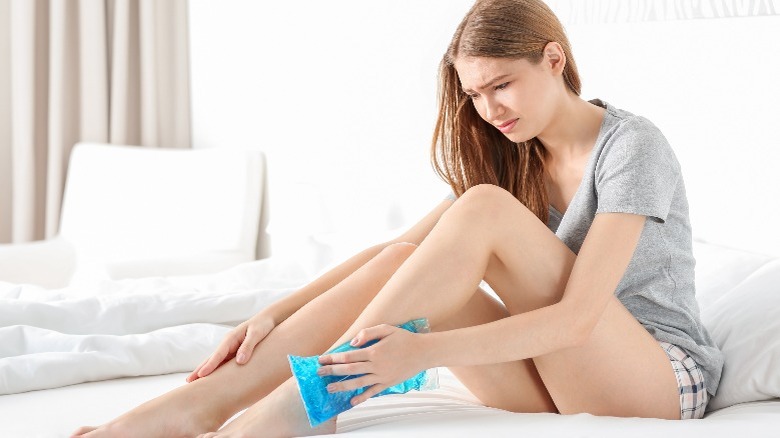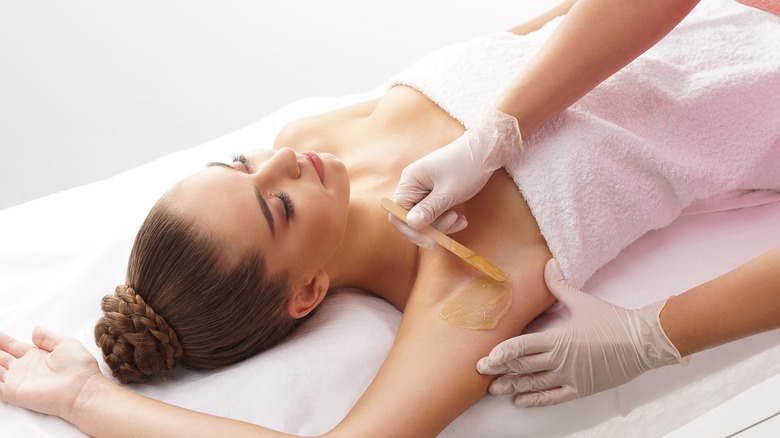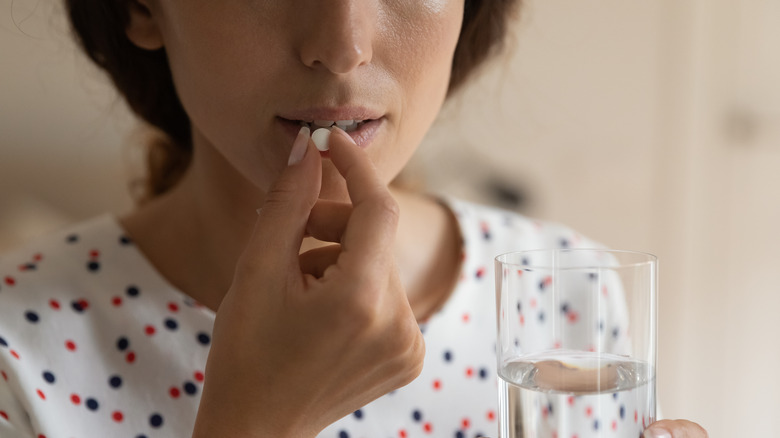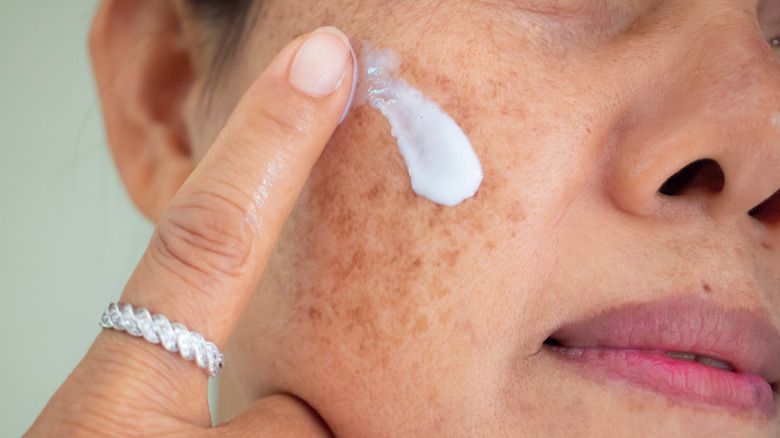8 Methods To Help Prevent Post-Waxing Dark Skin Spots
Bumps, dark spots, and rashes, oh my! Removing unwanted body hair and keeping your skin smooth can be exciting, but it's important to do it safely. Waxing is a common way to remove hair, but it can cause irritation, ingrown hairs, bumps, and discoloration (via WebMD). These effects can be temporary or long-lasting, depending on different factors. Discoloration and dark spots, medically known as hyperpigmentation, can occur following a DIY at-home waxing session or a professional treatment, according to CaronLab Australia. While skin pigment changes are not ideal, there are ways to make waxing less risky.
Hyperpigmentation results from too much melanin production, which causes patches that are darker than the rest of your skin, earning the name "dark spots." This can range from small spots to larger, tinted splotches, as detailed by Cleveland Clinic. Waxing can cause hyperpigmentation in shades of tan, pink, red, or gray, compounding physical sensitivity to touch, according to Healthline. Saying goodbye to body hair does not mean you want to say hello to dark spots, so learning how to properly care for your skin before, during, and after waxing can keep hyperpigmentation at bay.
Don't shave between waxing sessions
Waxing involves the application of hot wax onto body hair, which is then removed by quickly pulling off wax strips that press into the skin. This process removes both hair and layers of skin cells, resulting in immediate skin redness and trauma to the skin, as revealed by Skin Inc. Extended injury to the skin and prolonged inflammation can result in post-inflammatory hyperpigmentation (PIH), which occurs when the body produces abnormally high amounts of melanin when recovering from an injury or irritation, per WebMD.
As explained by WebMD, even without the presence of PIH, the process of waxing can lead to skin conditions like folliculitis. Folliculitis, as defined by Mayo Clinic, occurs when hair follicles become susceptible to irritation, inflammation, and potential infection. During waxing, the abrupt removal of hair strands from the follicles can create a favorable environment for inflammation or bacterial infection. Symptoms of folliculitis include the development of numerous pink, red, or skin-colored small bumps. Sometimes mistaken for acne or ingrown hairs, folliculitis is a unique condition and a common side effect of waxing treatments. To minimize pain, irritation, and inflamed patches of skin caused by folliculitis or PIH, Healthline recommended that users avoid shaving any waxed areas in between sessions.
Exfoliate the skin before waxing
According to Healthline, temporary skin discoloration, specifically shades of red and pink, is pretty common after waxing. Freshly waxed skin may even appear darker for a short time. A single waxing session is unlikely to create permanent dark spots, but repeated waxing of the same area may eventually lead to visibly darker patches of skin over time, stated Fazit.
As waxing, shaving, and other hair removal methods repeatedly damage skin (via Bushbalm), it becomes harder for the body to heal and increases the risk of PIH discoloration. Ingrown hairs incurred from waxing can further complicate the situation. Hair follicles with ingrown hairs can transpire with pus or appear as red bumps, which may come with inflammation-induced pain, especially if bumps from waxing are scratched, picked at, or otherwise further irritated (per Mayo Clinic). Various types of scarring are also possible, though ingrown hairs typically don't cause alarm for scars.
WebMD advised applying a washcloth to gently exfoliate the skin prior to waxing to remove dead skin cells, excess oil, and any lingering bacteria on the skin's surface. This proactive practice decreases the chances of clogged pores and post-waxing ingrown hairs.
Use temperature to ease inflammation
Taking proactive measures can make a world of difference in helping your body heal from waxing treatments and preventing unfavorable side effects like folliculitis and PIH. Spa Industry Association explained that using temperature-based at-home methods, such as cold ice packs and warm compresses, on the waxed area is one easy way to stop inflammation in its tracks. This is particularly effective following waxing treatments, as the application of ice and cold compresses can reduce associated inflammation and hasten healing. Johns Hopkins Medicine underscored that ice packs and cold compresses are effective means of reducing inflammation and pain.
After waxing, apply a cold compress to the treatment area to quell any existing inflammation. By decreasing inflammation in the waxed area, you can also help prevent post-inflammatory hyperpigmentation from developing. While an ice pack should be your go-to directly after a waxing session, warm compresses can also play an important role after you've taken care of the inflammation (per Brazils Waxing Center). They are especially effective for stopping ingrown hairs from developing, thus further lowering the chance of hyperpigmentation.
While warm and cold compresses cannot guarantee the total absence of skin discoloration, they can minimize adverse results, allowing you to enjoy your freshly hair-free skin without fretting about impending side effects such as dark spots.
Sun protection is the pinnacle of post-waxing skincare
It's important to remember that the risk of developing waxing-related dark spots extends beyond the waxing procedure itself. After waxing, one of the most common reasons for dark spots and skin discoloration is exposure to sunlight and ultraviolet (UV) rays. Tanning and sunbathing should be avoided to prevent this (via HerZindagi). Although UV exposure can increase the risk of discoloration, hyperpigmentation, and dark spots at all times, that risk is multiplied when skin is raw, sensitive, and injured following the use of hot wax and the forcible ripping of waxing strips used during wax-based hair removal treatments. Skin in such a vulnerable condition creates a ripe opportunity for sunlight to exacerbate skin damage, said Beauty Image.
After waxing skin, it is essential to apply sunscreen more than ever to prevent painful sunburns and dark spots. Similarly, applying aloe vera to inflamed or irritated skin post-waxing treatment can be done in the same manner as sunburns are treated, as revealed by Leaf. WebMD emphasized that UV damage heavily contributes to the potential development of hyperpigmentation and dark spots, along with deeper, prolonged damage. It is important to give the skin sufficient time to heal before spending time outdoors. Once outside, wearing a wide-brimmed hat and applying sunscreen is recommended.
Treat heat-related effects on the skin
Skin discoloration is a common occurrence after waxing, but not all color changes are indicative of hyperpigmentation or long-term side effects. The skin can look red due to irritation from the temperature of the wax and the intensity of ripping off firmly-pressed wax strips, which is a natural response of the body to heat and injury, according to Leaf. Healthline revealed that burns can even result from waxing skin. According to Medical News Today, hyperpigmentation can result from burn-based injuries, and such burns require appropriate aftercare to prevent discoloration and infection.
To prevent potential infection from waxing burns, Healthline suggested applying antibacterial ointment. Aloe vera or honey may also soothe the burned area. Additionally, a study published in the Indian Journal of Plastic Surgery suggested that green tea may be effective for treating burns. A second study shared in the International Journal of Molecular Sciences indicated that one of the micronutrients in green tea reduced melanin production, which could help minimize dark spots from hyperpigmentation. Ice can also help treat heat-related injuries, but you should always place it inside a laundered cloth and not directly against the burned skin.
Proactively address waxing-induced inflammation
Whenever hair is forcibly removed from its follicle, such as during a waxing session, the body detects injury and promptly deploys healing measures. According to The Regimen by Vivant Skincare, the body's first line of defense focuses on repairing the damage caused by waxing to hair follicles and skin cells. This is achieved through natural repair measures similar to bandages or scabs that mend micro-fissures. To isolate the body's defense mechanisms of injured skin cells and hair follicles, the body initiates inflammatory responses in the area. Cleveland Clinic reported that inflammation can provoke hyperpigmentation through rapid melanin-containing skin cell growth within inflamed tissue.
Johns Hopkins Medicine explained that acute inflammation can indicate cellular damage and trauma and that inflammation itself can be painful due to swelling and irritation. To mitigate post-waxing inflammation, it is best to address it before the waxing session even begins, as recommended by WebMD. Prior to waxing, take Advil, Ibuprofen, or another non-steroidal anti-inflammatory drug (NSAID). Continue taking NSAIDS at recommended intervals until inflammation has subsided post-waxing. NSAIDS have pain-relieving effects, making the waxing process more comfortable if taken proactively beforehand. Additionally, GoodRx recommended anti-inflammatory creams and gels as pain-relieving options, but it is important to check with your practitioner regarding the safety of applying topicals both pre- and post-waxing.
Protect skin as it heals
Post-waxing skincare involves avoiding further irritation of recently waxed skin, staying away from sources of heat and sunlight, and keeping track of any side effects (via Signature Medical Spa). Proper care of freshly waxed skin can mitigate hyperpigmentation from developing later on, an experience which can manifest even if the skin appears visibly unaffected post-waxing, said WebMD. After waxing, it is essential to wear sunscreen whenever going outside and avoid hot tubs and hot showers for at least a full day to prevent inflammation and burn-like effects, which can further injure the skin and/or prevent proper healing, stated Cleveland Clinic. The more expert-backed healing recommendations are followed, the lower the potential of developing dark spots.
Allow your skin to recover in an airy space and wear breathable clothing as your body works its mending magic, advised Skin pH Murfreesboro. Depending on factors like weather, your lifestyle, and daily responsibilities, wear loose-fitting and baggy garments that won't rub against the waxed area. Tight, restrictive, or abrasive clothing worn after waxing sessions risks exacerbating irritation. Cleveland Clinic recommended avoiding activities that could expose recently waxed skin to abrasion, including sexual activities, and positioning yourself on furniture or bedding with itchy fabrics that could rub against sensitive, vulnerable skin. To help your body heal, go back to basics by drinking water, eating nutritious foods, and prioritizing sleep.
Skincare options for persistent dark spots from prolonged waxing
If you experience discoloration due to waxing that persists even after you've stopped treatments, both at-home and in-office dermatology options for reducing hyperpigmentation's appearance and even eliminating dark spots are available, according to Schweiger Dermatology Group. With patience and consistency in sustaining skincare practices, there are plenty of ways to treat prolonged hyperpigmentation and lessen the visibility of dark spots. American Academy of Dermatology Association recommended incorporating into your skincare routine ingredients proven to lighten dark spots and reduce the appearance of hyperpigmentation.
Products that are optimal for lessening hyperpigmentation are labeled as having skin-lightening solutions or brightening effects, as reported by Self. Shining at the top of the list are retinoids and vitamin C-rich products including serums, moisturizers, and combination solutions with both vitamin C and SPF. Azelaic acid provides added benefits, having naturally derived antibacterial properties to ward off infection-inducing bacteria while reducing the appearance of dark spots.
It is important to note that some ingredients can make skin more susceptible to sun damage, including retinol, kojic acid, azelaic acid, and glycolic acid. According to WebMD, these ingredients enhance the skin's susceptibility to damage from UV rays and potentially raise the risk for increased hyperpigmentation. Sun protection is your golden ticket to saying goodbye to waxing-induced dark spots. When in doubt, apply and re-apply sunscreen while taking advantage of the available shade to shield your skin.
